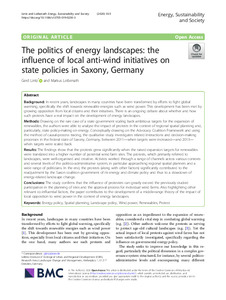| dc.date.accessioned | 2021-11-04T14:08:59Z | |
| dc.date.available | 2021-11-04T14:08:59Z | |
| dc.date.issued | 2020-01-23 | |
| dc.identifier | doi:10.17170/kobra-202110284989 | |
| dc.identifier.uri | http://hdl.handle.net/123456789/13360 | |
| dc.language.iso | eng | eng |
| dc.rights | Namensnennung 4.0 International | * |
| dc.rights.uri | http://creativecommons.org/licenses/by/4.0/ | * |
| dc.subject | energy policy | eng |
| dc.subject | spatial planning | eng |
| dc.subject | landscape policy | eng |
| dc.subject | wind power | eng |
| dc.subject | renewables | eng |
| dc.subject | protest | eng |
| dc.subject.ddc | 333 | |
| dc.title | The politics of energy landscapes: the influence of local anti-wind initiatives on state policies in Saxony, Germany | eng |
| dc.type | Aufsatz | |
| dcterms.abstract | Background
In recent years, landscapes in many countries have been transformed by efforts to fight global warming, specifically the shift towards renewable energies such as wind power. This development has been met by growing opposition from local citizens and their initiatives. There is an ongoing debate about whether and how such protests have a real impact on the development of energy landscapes.
Methods
Drawing on the rare case of a state government scaling back ambitious targets for the expansion of renewables, the authors were able to analyse the impact of protests in the context of regional spatial planning and, particularly, state policy-making on energy. Conceptually drawing on the Advocacy Coalition Framework and using the method of causal-process tracing, the qualitative study investigates related interactions and decision-making processes in the federal state of Saxony, Germany, between 2011—when targets were increased—and 2013—when targets were scaled back.
Results
The findings show that the protests grew significantly when the raised expansion targets for renewables were translated into a higher number of potential wind farm sites. The protests, which primarily referred to landscapes, were well-organised and creative. Activists worked through a range of channels across various contexts and several levels of the politico-administrative system, in particular approaching regional spatial planners and a wide range of politicians. In the end, the protests (along with other factors) significantly contributed to the readjustment by the Saxon coalition government of its energy and climate policy and thus to a slowdown of energy-related landscape change.
Conclusions
The study confirms that the influence of protesters can greatly exceed the previously studied participation in the planning of sites and the approval process for individual wind farms. Also highlighting other relevant co-influential factors, the paper contributes to the development of a middle-range theory of the impact of local opposition to wind power in the context of energy landscapes. | eng |
| dcterms.accessRights | open access | |
| dcterms.creator | Lintz, Gerd | |
| dcterms.creator | Leibenath, Markus | |
| dc.relation.doi | doi:10.1186/s13705-019-0230-3 | |
| dc.subject.swd | Energiepolitik | ger |
| dc.subject.swd | Raumordnung | ger |
| dc.subject.swd | Landschaftsgestaltung | ger |
| dc.subject.swd | Windenergie | ger |
| dc.subject.swd | Erneuerbare Energien | ger |
| dc.subject.swd | Protest | ger |
| dc.type.version | publishedVersion | |
| dcterms.source.identifier | eissn:2192-0567 | |
| dcterms.source.journal | Energy, Sustainability and Society | eng |
| dcterms.source.volume | Volume 10 | |
| kup.iskup | false | |
| dcterms.source.articlenumber | 5 | |


